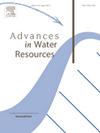Solving the discretised shallow water equations using neural networks
IF 4
2区 环境科学与生态学
Q1 WATER RESOURCES
引用次数: 0
Abstract
We present a new approach to the discretisation and solution of the Shallow Water Equations (SWE) based on the finite element (FE) method. The discretisation is expressed as the convolutional layer of a neural network whose weights are determined by integrals of the FE basis functions. The resulting system can be solved with explicit or implicit methods. Expressing and solving discretised systems with neural networks has several benefits, including platform-agnostic code that can run on CPUs, GPUs as well as the latest processors optimised for AI workloads; the model is fully differentiable and suitable for performing optimisation tasks such as data assimilation; easy integration with trained neural networks that could represent sub-grid-scale models, surrogate models or physics-informed approaches; and speeding up the development of models due to the available functionality in machine-learning libraries. In this paper, we investigate explicit and semi-implicit methods, and FE discretisations of up to quartic-order elements. A variety of examples is used to demonstrate the neural-network–based SWE solver, ranging from idealised problems with analytical solutions to laboratory experiments, and we finish with a real-world test case based on the 2005 Carlisle flood.
用神经网络求解离散浅水方程
提出了一种基于有限元法的浅水方程离散解的新方法。离散化表示为神经网络的卷积层,其权重由FE基函数的积分决定。结果系统可以用显式或隐式方法求解。用神经网络表达和解决离散系统有几个好处,包括可以在cpu、gpu以及针对人工智能工作负载优化的最新处理器上运行的平台无关代码;该模型是完全可微的,适合执行优化任务,如数据同化;与训练有素的神经网络轻松集成,可以表示亚网格尺度模型,代理模型或物理信息方法;由于机器学习库中可用的功能,加速了模型的开发。在本文中,我们研究了显式和半隐式方法,以及高达四阶元素的有限元离散。我们使用了各种各样的例子来演示基于神经网络的SWE求解器,从具有分析解决方案的理想问题到实验室实验,我们以基于2005年卡莱尔洪水的真实测试案例结束。
本文章由计算机程序翻译,如有差异,请以英文原文为准。
求助全文
约1分钟内获得全文
求助全文
来源期刊

Advances in Water Resources
环境科学-水资源
CiteScore
9.40
自引率
6.40%
发文量
171
审稿时长
36 days
期刊介绍:
Advances in Water Resources provides a forum for the presentation of fundamental scientific advances in the understanding of water resources systems. The scope of Advances in Water Resources includes any combination of theoretical, computational, and experimental approaches used to advance fundamental understanding of surface or subsurface water resources systems or the interaction of these systems with the atmosphere, geosphere, biosphere, and human societies. Manuscripts involving case studies that do not attempt to reach broader conclusions, research on engineering design, applied hydraulics, or water quality and treatment, as well as applications of existing knowledge that do not advance fundamental understanding of hydrological processes, are not appropriate for Advances in Water Resources.
Examples of appropriate topical areas that will be considered include the following:
• Surface and subsurface hydrology
• Hydrometeorology
• Environmental fluid dynamics
• Ecohydrology and ecohydrodynamics
• Multiphase transport phenomena in porous media
• Fluid flow and species transport and reaction processes
 求助内容:
求助内容: 应助结果提醒方式:
应助结果提醒方式:


